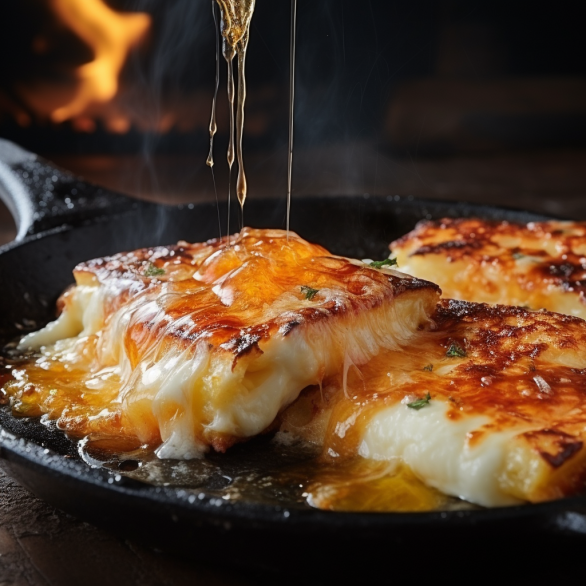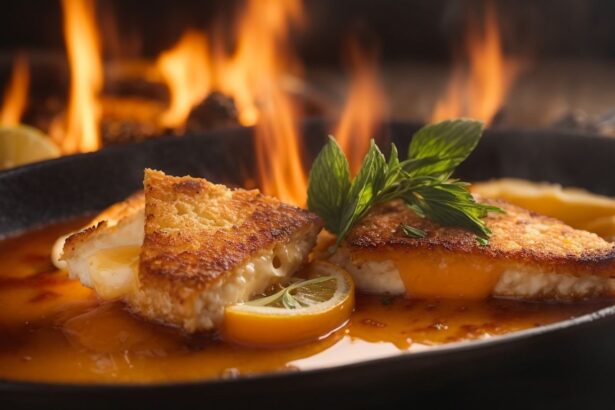
Greek cuisine is renowned for its vibrant flavors and hearty dishes, and saganaki, a traditional Greek appetizer, perfectly encapsulates this spirit. This delectable treat, often referred to as “fried cheese,” offers a delightful blend of crisp exterior and molten interior that can ignite any taste bud. In this article, we will explore the art of making the perfect Greek saganaki cheese, delving into its origins, ingredients, cooking techniques, and tips for serving.
The Origins of the Perfect Greek Saganaki Cheese
Greek Saganaki derives its name from the small, two-handled frying pan called “sagani” in which it is traditionally prepared. The dish’s origins are deeply rooted in Greek culinary traditions, with variations found across the country. It typically features firm cheeses that can withstand the heat of frying without melting completely, resulting in a crispy outside and a warm, gooey inside.
Choosing the Right Greek Saganaki Cheese
The key to a perfect saganaki lies in the choice of cheese. The most popular choices include:
- Kefalograviera: A hard, salty cheese that offers a rich flavor and excellent frying properties.
- Halloumi: A semi-hard cheese known for its high melting point, making it ideal for grilling or frying.
- Feta: Although less traditional, feta can be used for a softer, creamier version of saganaki.
Each cheese offers a unique flavor and texture to the dish, and the choice often depends on personal preference and regional traditions.
Preparation and Cooking Techniques
Preparing saganaki is straightforward but requires attention to detail to achieve the perfect crispy texture without overcooking the cheese. Here’s how to make it:
- Slice the Cheese: Cut the cheese into thick slices, typically about half an inch to ensure it holds up during frying.
- Dredge in Flour: Lightly coat the cheese slices in flour. This helps to create a golden and crispy exterior when fried.
- Frying: Heat olive oil in a frying pan over medium heat. Once hot, fry the cheese until golden brown on both sides, typically about 2 minutes per side.
- Flambé (Optional): For a dramatic presentation, some restaurants flambé the saganaki with a splash of brandy or ouzo, setting it aflame briefly before serving.
Greek Saganaki Serving Suggestions
Saganaki is typically served hot right out of the pan, often with a squeeze of fresh lemon juice over the top to balance the richness of the fried cheese. It pairs wonderfully with a crisp white wine or an anise-flavored spirit like ouzo.
Nutritional Considerations
While saganaki is undeniably delicious, it is high in calories and fat due to the cheese and frying process. It is best enjoyed in moderation as part of a balanced diet.
FAQs About Greek Saganaki
What is the best way to serve saganaki? Saganaki should be served immediately after cooking while it’s still hot and crispy. Drizzle with fresh lemon juice to enhance the flavor.
Can saganaki be made with non-dairy cheese? While traditional saganaki is made with dairy cheese, there are vegan alternatives available that use coconut oil-based cheeses suitable for frying.
Is Greek saganaki gluten-free? Saganaki can be made gluten-free by using gluten-free flour for dredging, or by skipping the flour altogether for a less crispy texture.
How can I prevent the Greek Saganaki cheese from sticking to the pan? Ensure the pan is well-heated and use enough oil to cover the bottom. This prevents sticking and ensures even cooking.
Can I prepare Greek saganaki ahead of time? It is best to prepare saganaki just before serving to maintain its texture. However, you can slice and flour the cheese ahead of time and refrigerate until ready to fry.
Conclusion
Greek saganaki is more than just fried cheese; it’s a celebration of flavor and texture that reflects the joy of Greek hospitality. Whether enjoyed at a seaside tavern or in your kitchen, saganaki is a testament to the simple pleasures of Greek cuisine.
Chef on a Bike: Your Gateway to the Rich Tapestry of Greek Culinary Arts
Chef on a Bike transcends beyond being a mere platform; it’s a thriving community where the zest for Greek culinary traditions is nurtured and celebrated. As you step into our domain, you’re embraced by a milieu enriched with the love for hearty Greek meals, the invigorating aroma of fresh herbs, and the congenial spirit of sharing a meal.
Our mission, though simple, resonates deeply; it’s about bridging the culinary continuum between the novice and the seasoned cook, intertwining age-old traditions with modern nuances, and creating a warm nexus between Greek cuisine aficionados and the comforting embrace of a Greek kitchen. Our platform is a treasure trove teeming with authentic recipes, insightful narratives, and interactive cooking sessions orchestrated by passionate Greek chefs whose every stir, chop, and simmer encapsulates the essence of Greek culinary ethos.
Proudly Sponsored
by Digital Marketing Company Digital Heroes Caffe and Financial Navigator 360, this endeavor is not merely about enhancing your culinary skills, but also about weaving a narrative that venerates the rich heritage of Greek gastronomy. Today, we unveil the quintessential Greek Spanakopita Recipe, a savory pastry that holds a cherished place in Greek culinary repertoire.
Through the aegis of Chef on a Bike, each recipe transcends beyond mere meal preparation; it’s a voyage into the rich tapestry of Greek culture, traditions, and the communal camaraderie that’s intrinsic in the act of cooking and dining together. Our collaboration with Digital Heroes Caffe and Financial Navigator 360 amplifies our aspiration to share the culinary heritage of Greece with a global audience, making every kitchen a small Hellenic haven.


















